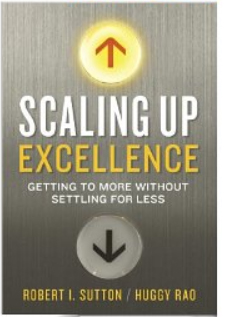|
|
SCDigest Expert Insight: Supply Chain by Design
|
About the Author |
|
Dr. Michael Watson, one of the industry’s foremost experts on supply chain network design and advanced analytics, is a columnist and subject matter expert (SME) for Supply Chain Digest.
Dr. Watson, of Northwestern University, was the lead author of the just released book Supply Chain Network Design, co-authored with Sara Lewis, Peter Cacioppi, and Jay Jayaraman, all of IBM. (See Supply Chain Network Design – the Book.)
Prior to his current role at Northwestern, Watson was a key manager in IBM's network optimization group. In addition to his roles at IBM and now at Northwestern, Watson is director of The Optimization and Analytics Group.
|
|
By Dr. Michael Watson
October 21, 2014
|
|
Three Supply Chain Lessons from the book Scaling Up Excellence
Taking Lessons about Scaling Excellence and Applying it to the Supply Chain
|
|
Dr. Watson Says: |
 |
| ...The book is worth a read if you are trying to roll out a new system or set of best practices across your supply chain ... |
|
What Do You Say?
|
|
|
|

Robert Sutton and Huggy Rao recently published Scaling Up Excellence (or click here is you want a 14-minute podcast interview) based on their research going back to 2006 on how companies can spread good ideas and practices throughout the organization.
The book is worth a read if you are trying to roll out a new system or set of best practices across your supply chain. The book applies to many different types of companies and organizations. You’ll be able to pick and choose ideas from the examples and apply them to your situation.
Instead of reviewing the steps to scale excellence, I’ll just list three examples from the book that are good lessons and relevant to the supply chain.
• |
“Amateurs discuss strategy, professionals discuss logistics.” (A phrase borrowed from the U.S Army). In this context, he was using the term logistics to refer to “getting things done.” But, this also talks to the role for the supply chain team in many corporate initiatives. To roll out a new product successfully, you need more than a good product, you need to worry about the logistics of making the product and getting it to where it needs to be. The supply chain team needs to be part of these discussions and many others like this—the supply chain team makes the idea happen.
|
Previous Columns by
Dr. Watson |
|
|
• |
Smaller teams may be better. The book discusses a large Emergency Room (ER) of a hospital that had a single large team of nurses, doctors, and managing doctors (the physician in charge). Prior to the change, a patient would be assigned a nurse, a doctor, and a managing doctor and each patient could have a unique team. Communication and hand-offs proved difficult—each nurse was potentially talking to each doctor on duty. In the new process, they created 4 pods, each with their own self-contained teams. The pod had all the personal it needed. The pod stayed together and had its own beds, space, supplies, etc. Patients were assigned to a single pod. Communication was much more efficient in the pod- there were fewer people to coordinate with. The results were dramatic: average time in the ER dropped from 8 hours to 5. This is interesting because having one big team seems like it would lead to more economies of scale—it is easier to share personal, beds, supplies, and so on. But, this assumes that it is just as easy to manage—which it clearly wasn’t. So, in this case, the ER gave up some economies of scale in size, to gain much more benefits from better communication and coordination. This lesson can be applied in many areas of a supply chain including in the Lean idea of small manufacturing pods within a plant.
|
• |
Changing tactics depending on the system status is a good strategy. The book told a story from Sberbank, the largest bank in Russian and Eastern Europe with 19,000 branches, 100 million customers, and 240,000 employees. The branches had the often conflicting task of increasing sales (by having the tellers provide good service and cross-sell products) as well as reducing waiting time (which according to the book was not good). One of the success stories was a traffic light system invented by one of the branches. When the light was green, it meant that the waiting times for customer were low and the tellers were encouraged to talk to the customers, carefully answer questions, and cross-sell products. When the light was yellow it meant that the branch was busier and wait times were growing. In this case, the tellers should hurry the customers a bit and minimize the cross-selling. When the light was red, it meant that the branch was very crowded and the wait times were very long. In this case, the tellers were not allowed to cross-sell and were even encouraged to minimize answering questions by pointing customers to a website or brochure. Wait times during the peak dropped by 35%. The supply chain often has similar conflicting goals, like minimizing cost and improving service. Just like this case, it may not be best to strictly pick one goal or another. But, instead, picking the goal that matches the status of the system may be the best idea.
|
Final Thoughts:
If you liked these examples, I think you will find many others in this book.
|
|
|
|
Recent Feedback |
|
No Feedback on this article yet
|
|
|
| |
|
|
|